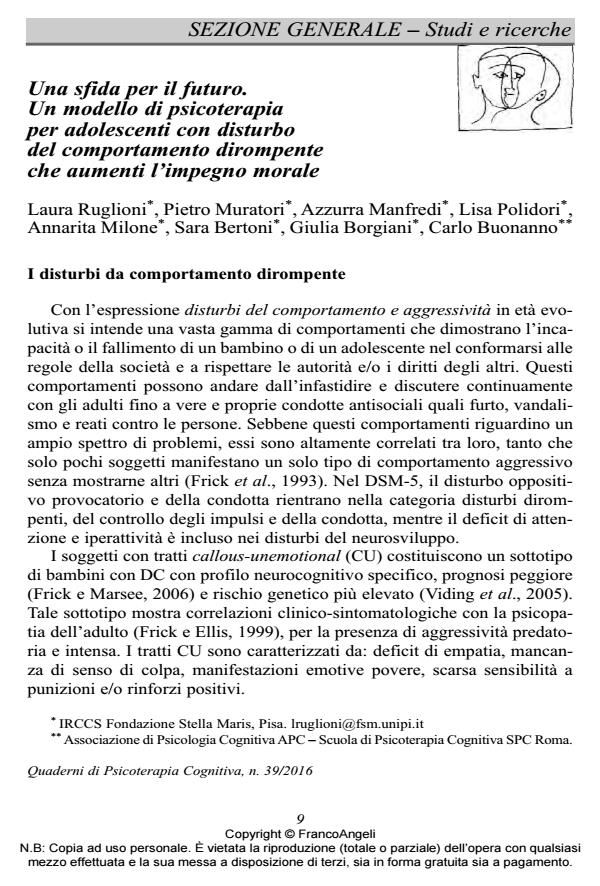A challenge for the future. A model of psychotherapy for adolescents with disruptive behavior disorder that increases the moral commitment
Journal title QUADERNI DI PSICOTERAPIA COGNITIVA
Author/s Laura Ruglioni, Pietro Muratori, Azzurra Manfredi, Lisa Polidori, Annarita Milone, Sara Bertoni, Giulia Borgiani, Carlo Buonanno
Publishing Year 2016 Issue 2016/39
Language Italian Pages 16 P. 9-24 File size 116 KB
DOI 10.3280/QPC2016-039002
DOI is like a bar code for intellectual property: to have more infomation
click here
Below, you can see the article first page
If you want to buy this article in PDF format, you can do it, following the instructions to buy download credits

FrancoAngeli is member of Publishers International Linking Association, Inc (PILA), a not-for-profit association which run the CrossRef service enabling links to and from online scholarly content.
Disruptive Behaviour Disorders (DBD), including Oppositional Defiant Disorder (ODD) and Conduct Disorder (CD), are among the most common reasons for referring children and adolescents to outpatient clinics in Italy (Frigerio et al., 2006) as well as in other countries (Steiner e Remsing, 2007). Children with ODD and CD comprise a heterogeneous group of patients who engage in a broad array of problem behaviours, ranging from relatively minor defiance and temper tantrums to more serious violations such as physical aggression, destructiveness, and stealing (American Psychiatric Association, 2000). Children with ODD or CD are at risk of developing a variety of problems such as peer rejection, school failure, substance abuse and criminality (Burke, Arkowitz e Dunn, 2002; Odgers et al., 2008) with high costs for communities (Kolko et al., 2009). The persistence of child behavioural problems and their role in the development of later clinical problems highlights the need of further studies in the field of DBD risk factors (Martens, 2000; Simonoff et al., 2004).
Keywords: Disruptive Behaviour Disorder, risks factors, personal values, moral disengagement, psychotherapy
Laura Ruglioni, Pietro Muratori, Azzurra Manfredi, Lisa Polidori, Annarita Milone, Sara Bertoni, Giulia Borgiani, Carlo Buonanno, Una sfida per il futuro. Un modello di psicoterapia per adolescenti con disturbo del comportamento dirompente che aumenti l’impegno morale in "QUADERNI DI PSICOTERAPIA COGNITIVA" 39/2016, pp 9-24, DOI: 10.3280/QPC2016-039002